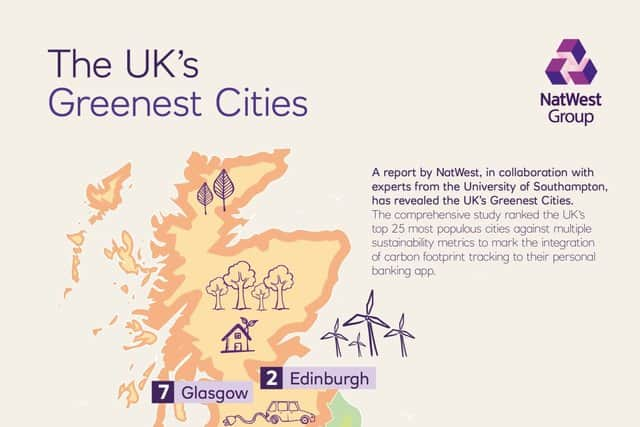Why Bristol has come fifth in a list of the UK’s greenest cities


Bristol has been named the fifth greenest city in the UK - partly thanks to having the highest proportion of people who regularly use their bike.
But our city was let down by a lack of green space per resident.
Advertisement
Hide AdAdvertisement
Hide AdThe Natwest Green Cities, done with expects from the University of Southampton, ranked 25 of the UK’s most populous cities, with Sheffield coming top and Wolverhampton at the bottom.
Seventeen criteria were considered and weighted, with cities positioned based on their scores of six overall categories: green space, energy use/production, motor vehicles, waste and recycling, commuting travel and pollution.
How Bristol scored
% who regularly commute by bike - 6.38% (highest of all cities studied)
% of waste recycled - 48.05% (3rd highest)
% of ULEZ Vehicles - 1.26% (just above the average of 1.22%)
Advertisement
Hide AdAdvertisement
Hide AdElectricity used per 1000 people (MWh) - 3798.3 (average 3847.7)
Green energy generated per 1000 people (MWh) - 37.4 (above the average of 19.9)
Green space (m2 per head) - 50.7 (below the average of 78.4)
Edinburgh was ranked the second greenest city and visually the greenest with the equivalent of 233.3m2 area of green space per head, one of the lowest numbers of car commuters and a high percentage of ULEZ vehicles.
Advertisement
Hide AdAdvertisement
Hide AdLondon was 11th on the list, with green credentials including a high number of ULEV vehicles per capita – due in part to residents getting ready for the expansion of the ULEZ zone on the 25th October – and 159,000 Londoners (3.5% of the city’s population) commuting by bike regularly.
Londoners also produce a relatively low amount of waste per person compared to other cities.
Green cities report
The research was commissioned as part of the bank’s climate strategy to support UK consumers in going greener and marks the launch of carbon footprint tracking on NatWest’s banking app - a first for a UK bank - in association with climate data experts CoGo.


David Lindberg, CEO, retail banking at NatWest, said: “It’s great to see cities like Sheffield and Edinburgh leading the way when it comes to creating a greener environment.
Advertisement
Hide AdAdvertisement
Hide Ad“We are extremely excited to be launching carbon footprint tracking in association with CoGo as a UK banking first. It empowers customers to manage their own carbon footprint, helping them to make small changes that can add up and help tackle climate change.
“We want to help set and raise the standards that the rest of the banking industry should follow.
“COP26 is an extraordinary opportunity for the UK to lead the world in tackling climate change.
“We are very proud of our partnership with COP26 which further highlights our determination to be the leader in the transition to a low carbon economy across the financial services industry.”
Advertisement
Hide AdAdvertisement
Hide AdProfessor William Powrie from the University of Southampton, the lead expert behind NatWest’s Green Cities report, said: “The key message from NatWest’s Green Cities Report is that we can and must all contribute to making our towns and cities as green as possible, so it could not have come at a more appropriate moment.
“The list will enable cities and people to reflect on their progress towards behaving sustainably. Simple changes can make a big difference - walking, cycling or using public transport rather than going by car, using less and recycling more; but we all need to get involved.”
“It’s great to see Sheffield scooping the accolade of the UK’s Greenest City, with schemes like their Grey to Green campaign creating high quality green recreational and active transport corridors, helping people behave more sustainably in their daily lives, and benefitting the city’s environmental trajectory.”
Ranked on a range of environmental data
In the most comprehensive study of its type to date, with lead input from Professor William Powrie, the UK’s 25 biggest cities by population were analysed and ranked using a range of environmental data.
Advertisement
Hide AdAdvertisement
Hide AdSeventeen criteria were considered and weighted, with cities ranked based on their scores of six overall categories: green space, energy use/production, motor vehicles, waste and recycling, commuting travel and pollution.
THE TOP 25 GREENIEST CITIES IN THE UK
- Sheffield
- Edinburgh
- Cardiff
- Brighton & Hove
- Bristol
- Leeds
- Glasgow
- Nottingham
- Newcastle upon Tyne
- Belfast
- London
- Salford
- Manchester
- Derby
- Wakefield
- Liverpool
- Plymouth
- Bradford
- Stoke-on-Trent
- Birmingham
- Hull
- Leicester
- Coventry
- Sunderland
- Wolverhampton
Comment Guidelines
National World encourages reader discussion on our stories. User feedback, insights and back-and-forth exchanges add a rich layer of context to reporting. Please review our Community Guidelines before commenting.